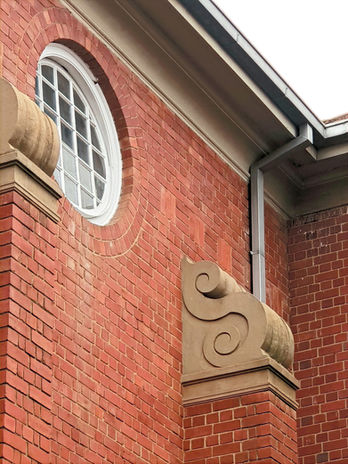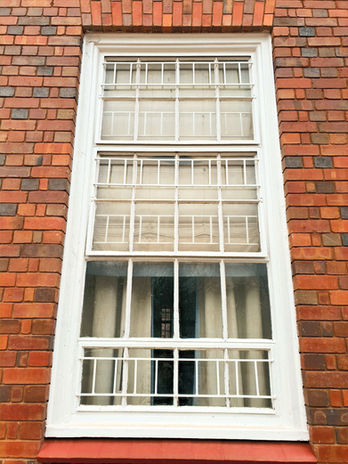
Your guide to Heidelberg Gauteng

#Hoër Volkskool
Heritage Blue Plaque #Nr 15
HOËR VOLKSKOOL HEIDELBERG - 1 Jacob Street
What is the story here?
On Wednesday Morning, the 1st of February 1922, the last farewell assembly of the high school students met in the “Monument Hall” of the Volkskool. The official opening was on the 3rd of February 1922. The children from both the High and Junior schools met at the Market Square and marched to the new building on “Opvoedingsbult”. It was an impressive sight to see the young boys and girls. At 4 o’clock, Minister A.J. Louw handed the keys to the Administrator, Mr. A. Robertson, to open the front door. The public went in and the children marched to the court yard, at the back of the building, singing “O goedheid Gods”.
Minister A.J. Louw played an important role in the establishment of the “Hoër Volkskool”. In 1907 the school commission recognised the need of a secondary school. In 1908 the first student to pass the matric exam was Justus D. Kilian. It was predicted that by 1913 there would be more than 150 students, above Standard 5, that would need secondary schooling.
In the December of the same year Mr. H. Weakley, secretary of the school commission of the Public School and editor of the “Heidelberg News” made a report that the amount of students needing a High School was justified and that it would be a source of students for the Normal College after a student had obtained their matric.
The official opening of the Hoër Volkskool happened on the 26th Of January 1915 in the presence of Sir John Adamson, the Director of Education. It was decided that the school would teach in both Afrikaans and English, so that students from both the “Volkskool” and “Heidelberg Public School”, would have a high school to go to.
The first staff members were, Meester A.J. Louw (Headmaster), Mr. J.J. Langenegger, Mr. J.P. Malan and Mr. Willie Viljoen. The first governing body was Ds. A.J. Louw (Chairman), Ds. P. Postma, Ds. H. Muller, Mr. L.J. Alberts, Mr. R.D. Collins, Mr. T.A. Donges, Mr. J.S. Joubert, Mr. W. Dyke Poynter and Mr. G.C. Bör.
On the 8th of September 1919 the cornerstone of the new school building was laid by the Administrator of the Transvaal, Mr. A.C. Robertson. On the 3rd of February 1922, after sharing premises for seven years, the new premises were occupied. The high school used the Van Belkum Hall, the hall of the Anglican Church, a closed down bottle store and various other buildings as classrooms.
HISTORY OF THE CHURCH HOSTELS
It’s interesting to note that the first hostel was already in use two years before the establishment of the High School. There would eventually be three hostels: “Transvalia” (1912), “Concordia” (1913), and “Excelsoir” (1923).
In February 1911, Mr. Wynand Louw, an architect from Paarl was approached to design a hostel and by May it was approved. “Transvalia” was officially opened on the 13th of February 1913.
After the completion of “Transvalia” it was proposed that another Hostel be built for Boys. In October 1914 the Administrator turned down the request, owing to the country’s financial position after the Rebellion. A year later, it was approved and on the 22nd of April 1916 the cornerstone of “Concordia” was laid. The Hostel could accomadate 83 boys with three teachers at a cost of £7791.1.0. At a later time both “Transvalia” and “Concordia” were enlarged.
Since 1912, the hostel on the Vereeniging Road was known as “Excelsior”. Mr. D.J.M. Jordaan was the hostel father. It was decided to build the third hostel and name it “Excelsior”. The building was built at a cost of £10 820 and 90 boys were accommodated in 1924. Wynand Louw was the architect again and Mr. J.S. Joubert the builder. (Note by Tony: The farm house in West Street, Jordaan was built and the home of Mr. J.S. Joubert and he is buried in the Heidelberg Kloof Cemetery).
The Hostels were owned by the church and leased to Education Department. The buildings eventually got old and deteriorated. In1959, the church board decided to sell the three properties to the Province. The names were carried over to the new hostels which were erected in 1965 on the previous Concordia and Excelsior hostels. The Towns library is built on the grounds that used to be occupied by the old “Transvalia” hostel.
(Source: “Pro Deo Et Patria” by Dr. A.E. Faul Bosman)
INITIATION OF NEW BUILDING
On Wednesday Morning, the 1st of February 1922, the last farewell assembly of the high school students met in the “Monument Hall” of the Volkskool.
The official opening was on the 3rd of February 1922. The children from both the High and Junior schools met at the Market Square and marched to the new building on “Opvoedingsbult”. It was an impressive sight to see the young boys and girls.
At 4 o’clock, Minister A.J. Louw handed the keys to the Administrator, Mr. A. Robertson, to open the front door. The public went in and the children marched to the court yard, at the back of the building, singing “O goedheid Gods”.
Minister J.C. Pauw did a powerful prayer and then Ds. Louw welcomed everyone and read a letter from the Director of Education who could not attend. Ds. Louw told a short history of the “Volkskool” and how the school is based on two foundations: Christianity and Nationality.
After a song by the choir the Administrator said a short speech and wished the parents, staff and children the best for the future. Meester Louw made the last speech and the proceedings closed with the song “Want goedertieren is de Heer.” In the evening the honoured guests, the teachers and governing body members were treated to a dinner in the Transvalia Hostel.
(Source: “ 1922 Ons Skoolblad”)
Notes by Tony: The school still have all the school’s yearly magazine from 1916 till now in their archives. (Except for 1921)
The Old Hall is now used by the “Hotel and Catering” classes as a restaurant. The wood used in the counter of the bar, comes from the stage that was removed to make way for the kitchen. 2 different busts of “Meester Louw” are mounted on the walls.
One notices the different shade of bricks on the outside of the school, at the back, where the school has been extended. There is a new hall and administration block that was built in 1990. One can see the remnants of the bicycle stands at the back of the hall when riding to school on a bicycle was the trend.
The school is looking after the “Sandstone Pulpit” of the Klipkerk that was removed to make way for a wooden pulpit.

























